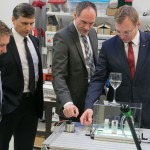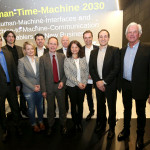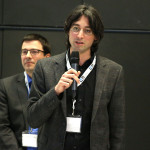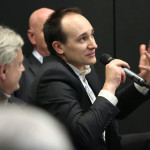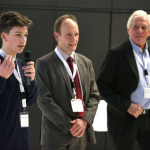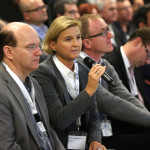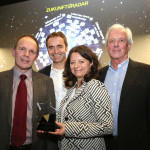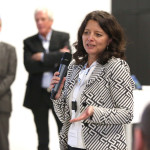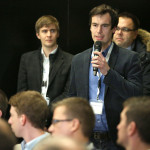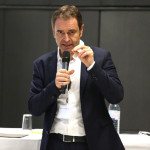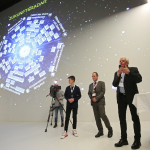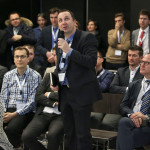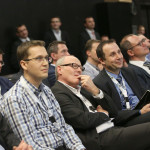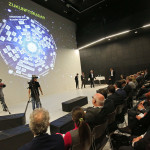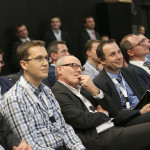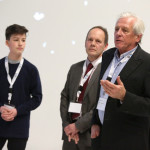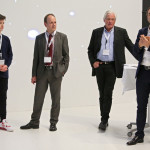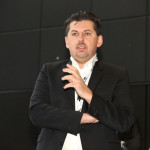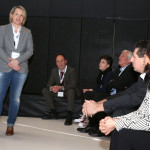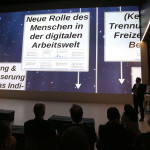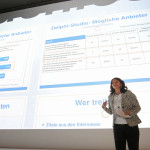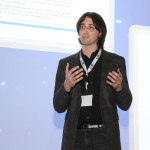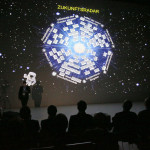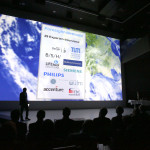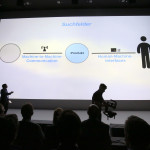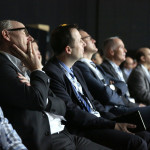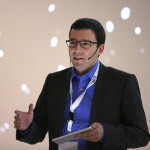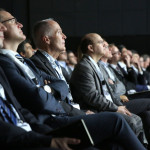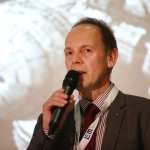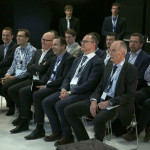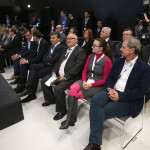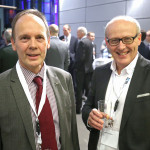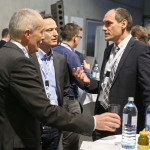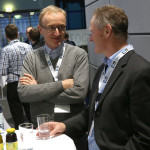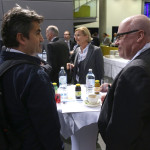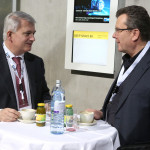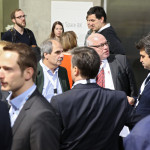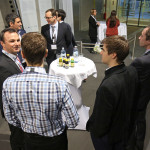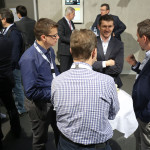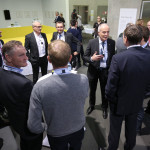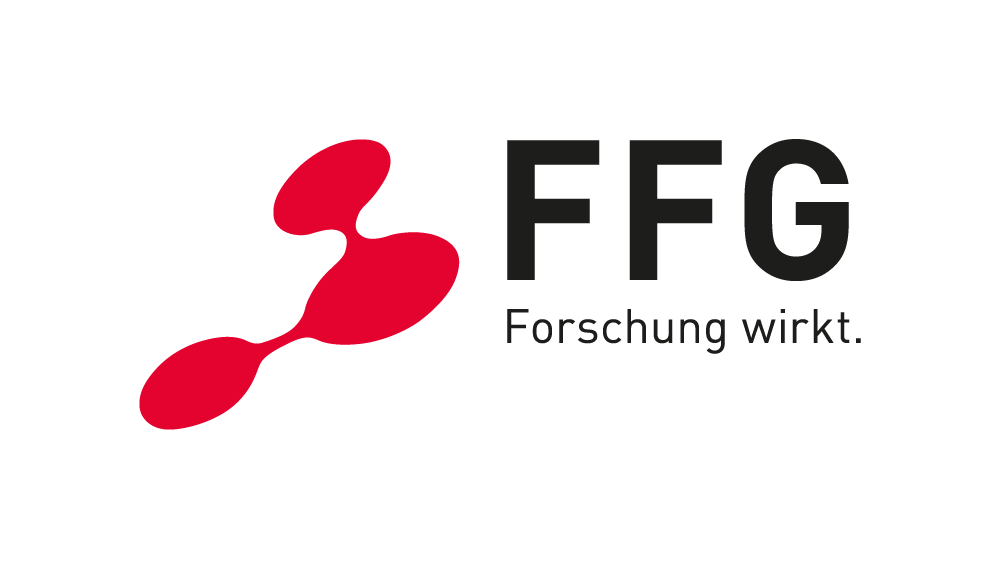Linz, 26.01.2016 – “Small fish like Pöttinger will have to come together to form a swarm if they want to survive against the bigger fish in our pond”. Lisa Wöss, Innovation Manager of the agricultural machinery company from Grieskirchen, outlines one of the key messages of the LCM study “Human-Time-Machine – Future Radar 2030”. In cooperation with the Institute for Strategic Management (ism) of the Johannes Kepler University Linz, LCM carried out a number of expert interviews, an international Delphi Study with 170 participants and several foresight workshops with the companies Atos, Fronius, LineMetrics, Pöttinger and Rosenbauer. On Monday night (25.10.2016), the results were presented to roughly 70 guests in the Ars Electronica Center, Linz.
“Maybe farmers will sit in offices in the year 2030 and direct their harvesters on the basis of data procured from a cloud that is, in turn, fed by data from multiple agriculture companies”, says Lisa Wöss, describing a perfectly realistic scenario for her company. She argues that, given the balance of power in the agricultural technology industry, the competitive situation of small companies has to be strengthened by forming consortia of firms. For example, global market leader John Deere, with 59,000 employees and annual sales of over US$ 36 billion, is still a Goliath in comparison to Pöttinger, with 1,600 employees and a turnover of EUR 317 million. “The courage to lay bare your data on a common platform of potential competitors in order to be able to digitalise complete process chains is something that has to be mustered in the interest of a common cause”, says Wöss. “This swarm intelligence -– i.e. smart farming – can help to ensure survival in a pond of major players”.
14-year-old sees irreversible technology leaps
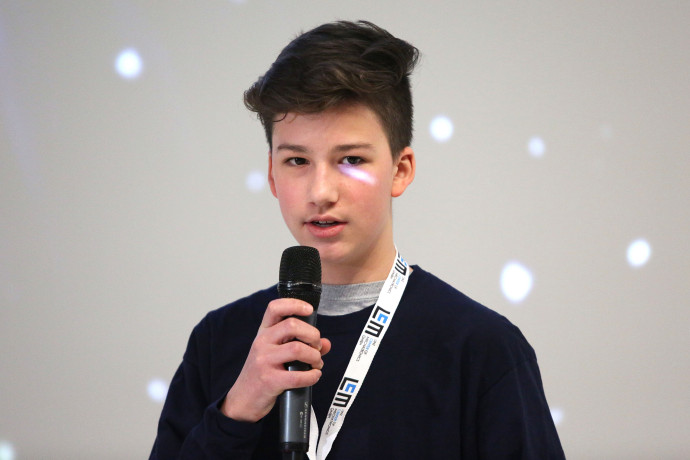
Bildcredits: LCM | Hermann Wakolbinger
The extent to which the digitalisation of agriculture is already thriving is outlined by 14-year-old entrepreneur and expert for disruptive innovations Lorenzo Tural. “Even now, there are fields of asparagus with special asparagus sensors that predict when the asparagus should be harvested based on subterranean measurement values and weather forecasts.” Advertising and sales campaigns are then adjusted accordingly. One trend that Tural already considers to be irreversible is the trend towards self-driving vehicles. “At some point, traditional cars from the inner cities will be banned because they are too dangerous. And at some point, drivers in today’s sense will only be turning to the wheel for nostalgia events.” According to Tural, the crux of technology is that it cannot be reversed and anyone that tries to hold out against the technological tide will ultimately become the odd ones out.
Machines that respond to emotions
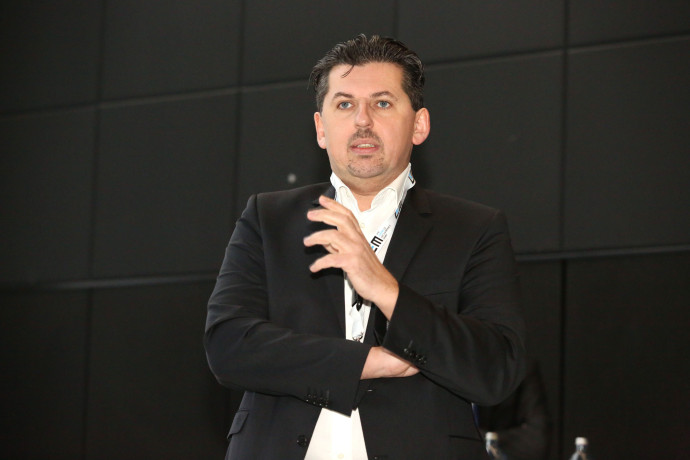
Bildcredits: LCM | Hermann Wakolbinger
As communication between humans and machines intensifies, one thing is clear for Bernhard Freiseisen, Strategic Planning in Fronius International GmbH: “Intelligent machines can now respond to gestures. Soon they will be able to respond to the emotions of their human counterparts and adjust their working speed accordingly.” The incipient turnaround from a product-oriented to a user-oriented industry will also open up new occupational fields. “In light of the ever-increasing digital information on customers and products, creative data interpretation will become a key qualification,” predicts Freiseisen. “The humanities disciplines will therefore also become more important in the technological industry.”
Great foundation of trust, vigorous discussions
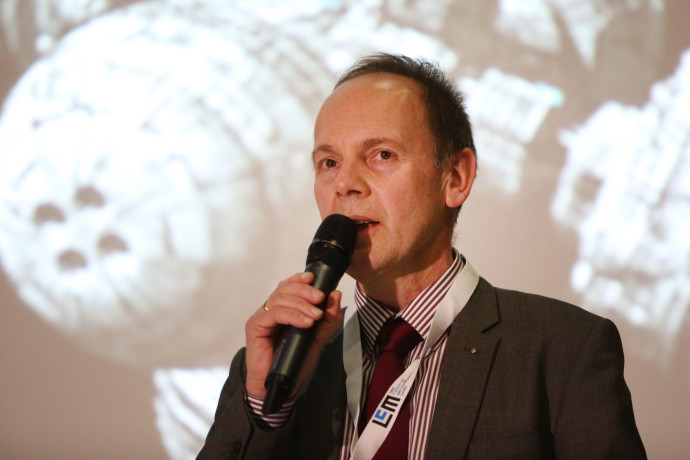
Bildcredits: LCM | Hermann Wakolbinger
In some sectors, no stone will be left standing, declares LCM CEO Gerald Schatz. 3D print in particular, a technology that enables the cost-efficient production of individual pieces, will render certain sectors virtually unrecognisable. “In China, the walls of a house can now be printed, and these can then be screwed together to form a complete house on site,” says Schatz, mentioning one possible disruptive development for the building industry. Similarly trailblazing is the concept of Local Motors, a company that is already offering cars from a 3D printer. The search to discover the future of the industry has led to vigorous discussions in workshops with Atos, Fronius, LineMetrics, Pöttinger and Rosenbauer. “On the other hand, signing a confidentiality clause was never needed, as a foundation of trust very quickly developed between all participants,” emphasises Schatz.
Stage already set to continue with time travel
While the companies involved in the first round of the future radar are about to translate the results into concrete pilot projects, the continuation of this initiative has already been decided. “This excursion into the future of industrial production has triggered an enormous echo. For this reason, we will offer the workshops this year also,” explains Thomas Buchegger, initiator of the “Human-Time-Machine – Future Radar 2030” and LCM employee.
Intermediate result in Deep Space
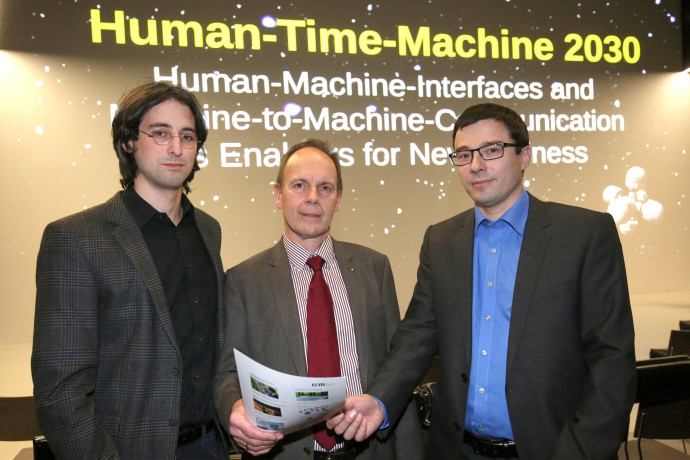
Bildcredits: LCM | Hermann Wakolbinger
With approx. 70 guests, the Deep Space of the Ars Electronica Center Linz was filled to capacity at the presentation of the first results of the “Human-Time-Machine – Future Radar 2030”. Among those travelling to the future of industrial production were company representatives of voestalpine, Palfinger AG, AVL List GmbH, Engel, Primetals Technologies Austria, Robert Bosch AG, PHOENIX CONTACT, SKIDATA, STIWA Automation, Salvagnini Maschinenbau GesmbH, Greiner, Keba, Trumpf and many others.
We would like to thank all our guests, speakers and contributors for the event. Here you will find a selection of pictures taken yesterday. For further questions on the event / photos / press material, please do not hesitate to contact Ms. Mag. Doris Prohaska, BSc, MBA, Marketing | Communication Linz Center of Mechatronics GmbH.
- Bildcredits: LCM | Hermann Wakolbinger
- Bildcredits: LCM | Hermann Wakolbinger
- Bildcredits: LCM | Hermann Wakolbinger
- Bildcredits: LCM | Hermann Wakolbinger
- Bildcredits: LCM | Hermann Wakolbinger
- Bildcredits: LCM | Hermann Wakolbinger
- Bildcredits: LCM | Hermann Wakolbinger
- Bildcredits: LCM | Hermann Wakolbinger
- Bildcredits: LCM | Hermann Wakolbinger
- Bildcredits: LCM | Hermann Wakolbinger
- Bildcredits: LCM | Hermann Wakolbinger
- Bildcredits: LCM | Hermann Wakolbinger
- Bildcredits: LCM | Hermann Wakolbinger
- Bildcredits: LCM | Hermann Wakolbinger
- Bildcredits: LCM | Hermann Wakolbinger
- Bildcredits: LCM | Hermann Wakolbinger
- Bildcredits: LCM | Hermann Wakolbinger
- Bildcredits: LCM | Hermann Wakolbinger
- Bildcredits: LCM | Hermann Wakolbinger
- Bildcredits: LCM | Hermann Wakolbinger
- Bildcredits: LCM | Hermann Wakolbinger
- Bildcredits: LCM | Hermann Wakolbinger
- Themenspezifische Vorträge
- Bildcredits: LCM | Hermann Wakolbinger
- Bildcredits: LCM | Hermann Wakolbinger
- Bildcredits: LCM | Hermann Wakolbinger
- Bildcredits: LCM | Hermann Wakolbinger
- Bildcredits: LCM | Hermann Wakolbinger
- Bildcredits: LCM | Hermann Wakolbinger
- Bildcredits: LCM | Hermann Wakolbinger
- Bildcredits: LCM | Hermann Wakolbinger
- Bildcredits: LCM | Hermann Wakolbinger
- Bildcredits: LCM | Hermann Wakolbinger
- Bildcredits: LCM | Hermann Wakolbinger
- Bildcredits: LCM | Hermann Wakolbinger
- Bildcredits: LCM | Hermann Wakolbinger
- Bildcredits: LCM | Hermann Wakolbinger
- Bildcredits: LCM | Hermann Wakolbinger
- Bildcredits: LCM | Hermann Wakolbinger
- Bildcredits: LCM | Hermann Wakolbinger


